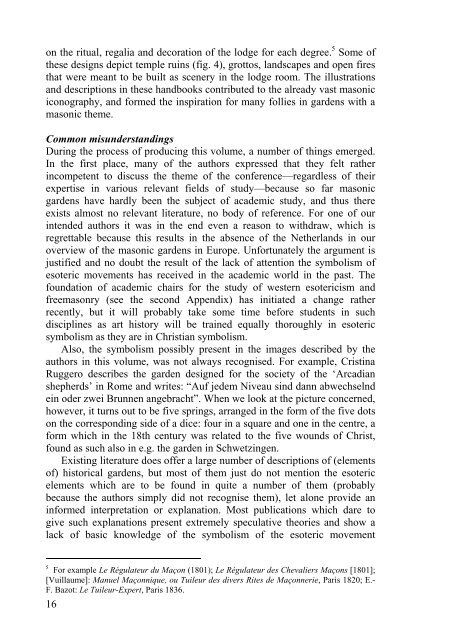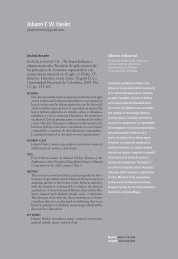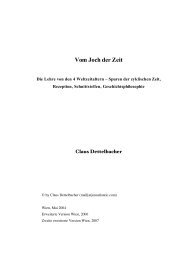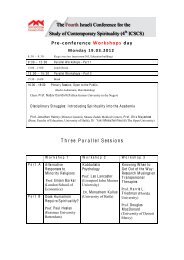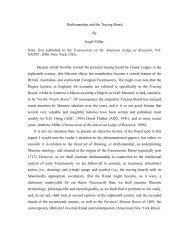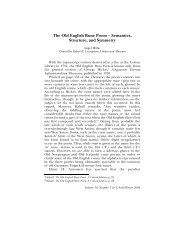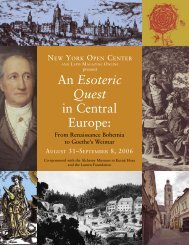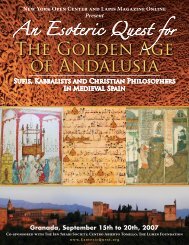Material for the introduction - Stichting OVN
Material for the introduction - Stichting OVN
Material for the introduction - Stichting OVN
Create successful ePaper yourself
Turn your PDF publications into a flip-book with our unique Google optimized e-Paper software.
on <strong>the</strong> ritual, regalia and decoration of <strong>the</strong> lodge <strong>for</strong> each degree. 5 Some of<br />
<strong>the</strong>se designs depict temple ruins (fig. 4), grottos, landscapes and open fires<br />
that were meant to be built as scenery in <strong>the</strong> lodge room. The illustrations<br />
and descriptions in <strong>the</strong>se handbooks contributed to <strong>the</strong> already vast masonic<br />
iconography, and <strong>for</strong>med <strong>the</strong> inspiration <strong>for</strong> many follies in gardens with a<br />
masonic <strong>the</strong>me.<br />
Common misunderstandings<br />
During <strong>the</strong> process of producing this volume, a number of things emerged.<br />
In <strong>the</strong> first place, many of <strong>the</strong> authors expressed that <strong>the</strong>y felt ra<strong>the</strong>r<br />
incompetent to discuss <strong>the</strong> <strong>the</strong>me of <strong>the</strong> conference—regardless of <strong>the</strong>ir<br />
expertise in various relevant fields of study—because so far masonic<br />
gardens have hardly been <strong>the</strong> subject of academic study, and thus <strong>the</strong>re<br />
exists almost no relevant literature, no body of reference. For one of our<br />
intended authors it was in <strong>the</strong> end even a reason to withdraw, which is<br />
regrettable because this results in <strong>the</strong> absence of <strong>the</strong> Ne<strong>the</strong>rlands in our<br />
overview of <strong>the</strong> masonic gardens in Europe. Un<strong>for</strong>tunately <strong>the</strong> argument is<br />
justified and no doubt <strong>the</strong> result of <strong>the</strong> lack of attention <strong>the</strong> symbolism of<br />
esoteric movements has received in <strong>the</strong> academic world in <strong>the</strong> past. The<br />
foundation of academic chairs <strong>for</strong> <strong>the</strong> study of western esotericism and<br />
freemasonry (see <strong>the</strong> second Appendix) has initiated a change ra<strong>the</strong>r<br />
recently, but it will probably take some time be<strong>for</strong>e students in such<br />
disciplines as art history will be trained equally thoroughly in esoteric<br />
symbolism as <strong>the</strong>y are in Christian symbolism.<br />
Also, <strong>the</strong> symbolism possibly present in <strong>the</strong> images described by <strong>the</strong><br />
authors in this volume, was not always recognised. For example, Cristina<br />
Ruggero describes <strong>the</strong> garden designed <strong>for</strong> <strong>the</strong> society of <strong>the</strong> ‘Arcadian<br />
shepherds’ in Rome and writes: “Auf jedem Niveau sind dann abwechselnd<br />
ein oder zwei Brunnen angebracht”. When we look at <strong>the</strong> picture concerned,<br />
however, it turns out to be five springs, arranged in <strong>the</strong> <strong>for</strong>m of <strong>the</strong> five dots<br />
on <strong>the</strong> corresponding side of a dice: four in a square and one in <strong>the</strong> centre, a<br />
<strong>for</strong>m which in <strong>the</strong> 18th century was related to <strong>the</strong> five wounds of Christ,<br />
found as such also in e.g. <strong>the</strong> garden in Schwetzingen.<br />
Existing literature does offer a large number of descriptions of (elements<br />
of) historical gardens, but most of <strong>the</strong>m just do not mention <strong>the</strong> esoteric<br />
elements which are to be found in quite a number of <strong>the</strong>m (probably<br />
because <strong>the</strong> authors simply did not recognise <strong>the</strong>m), let alone provide an<br />
in<strong>for</strong>med interpretation or explanation. Most publications which dare to<br />
give such explanations present extremely speculative <strong>the</strong>ories and show a<br />
lack of basic knowledge of <strong>the</strong> symbolism of <strong>the</strong> esoteric movement<br />
5 For example Le Régulateur du Maçon (1801); Le Régulateur des Chevaliers Maçons [1801];<br />
[Vuillaume]: Manuel Maçonnique, ou Tuileur des divers Rites de Maçonnerie, Paris 1820; E.-<br />
F. Bazot: Le Tuileur-Expert, Paris 1836.<br />
16


